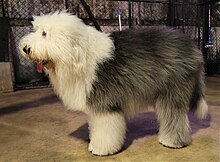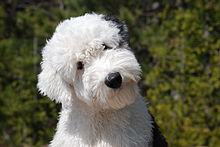Old English Sheepdog
| Old English Sheepdog | |||||||||||||||||||||||||
|---|---|---|---|---|---|---|---|---|---|---|---|---|---|---|---|---|---|---|---|---|---|---|---|---|---|
 A show-standard Old English Sheepdog | |||||||||||||||||||||||||
| Origin | England | ||||||||||||||||||||||||
| |||||||||||||||||||||||||
| |||||||||||||||||||||||||
| Dog (domestic dog) | |||||||||||||||||||||||||
The Old English Sheepdog is a large breed of dog that emerged in England from early types of herding dog. Other names for the breed include Shepherd's Dog and bob-tailed sheep-dog.[1] The nickname Bob-tail (or Bobtail) originates from how dogs of the breed traditionally had their tails docked. Old English Sheepdogs can grow very long coats with fur covering the face and eyes and do not shed unless brushed.[citation needed]
Appearance
[edit]The Old English Sheepdog is a large dog, immediately recognizable by its long, thick, shaggy grey and white coat, with fur covering their face and eyes. The ears lie flat to the head. Historically, the breed's tail was commonly docked (resulting in a panda bear–like rear end), but tailed Old English sheepdogs are now common, as many countries have outlawed cosmetic docking. When the dog has a tail, it has long fur (feathering), is low set, and normally hangs down.[2] The Old English Sheepdog stands lower at the shoulder than at the loin,[3] and walks with a "bear-like roll from the rear".[4]
Height at the withers is at least 61 cm (24 in), with females slightly smaller than males.[4] The body is short and compact with a deep chest and 'well-sprung' ribs.[4]
Colour of the double coat may be any shade of grey, grizzle, black, blue, or blue merle, with optional white markings. The undercoat is water resistant.[5] Puppies are born with a black and white coat, and it is only after the puppy coat has been shed that the more common grey or silver shaggy hair appears. Old English Sheepdogs only shed when they are brushed.[citation needed]
Docking
[edit]Undocked Old English Sheepdogs are becoming a more common sight as many countries have now banned docking. The Kennel Club (UK) and The Australian National Kennel Council breed standards do not express a preference for (legally) docked or un-docked animals, and either can be shown.[4][6] The American Kennel Club breed standard states that the tail should be "docked close to the body, when not naturally bob tailed",[5] even though the practice of cosmetic docking is now opposed by the American Veterinary Medical Association.[7]
History
[edit]
The Old English Sheepdog comes from the pastoral type dogs of England. A small drop-eared dog seen in a 1771 painting by Gainsborough is believed by some to represent the early type of the Old English Sheepdog.[8] In the early 19th century a bobtailed drovers dog, called the Smithfield or Cotswold Cor, was noticed in the southwestern counties of England and may have been an ancestor. Most fanciers agree that the Bearded Collie was among the original stock used in developing today's breed.[9] Some speculate that the Russian Owtchar was among the breed's ancestors.[according to whom?]
The Old English Sheepdog was at first called the "Shepherd's Dog" and was exhibited for the first time at a show in Birmingham, England, in 1873. There were only three entries, and the judge felt the quality of the dogs was so poor that he offered only a second placing.[9] From that beginning, the breed became a popular show dog, and, although the shape of the dog itself has changed very little over the years, elaborate grooming including backcombing and powdering the fur was recorded as early as 1907.[9] The breed was exported to the United States in the 1880s, and by the turn of the 20th century, five of the ten wealthiest American families bred and showed the Old English Sheepdog.[citation needed] The breed continues to be a popular show dog today.[citation needed]
The best recent finish of an Old English Sheepdog at the Westminster Kennel Club dog show was in 2013 when Bugaboo's Picture Perfect was awarded Reserve Best in Show.[10]
Health
[edit]A 2024 UK study found a life expectancy of 12.1 years for the breed compared to an average of 12.7 for purebreeds and 12 for crossbreeds.[11] The Old English Sheepdog is predisposed to allergic skin disease and demodicosis.[12]
An American study reviewing over a million patients presented to 27 veterinary teaching hospitals in North America found the Old English Sheepdog to be predisposed to hip dysplasia, with 11.1% of dogs examined having the condition compared to 3.52% overall.[13] Another American study of over a million hip evaluations in dogs over the age of 2 years found a prevalence of 17.8%.[14]
A review of 1,934 cases of dogs presenting for gastric dilatation volvulus (GDV) found the Old English Sheepdog to be predisposed, with an odds ratio of 4.8.[15] A UK survey attributed 7% of Old English Sheepdog deaths to GDV.[16]
A review of 369 cases of dilated cardiomyopathy in England found the Old English Sheepdog to make up 9 of those cases.[17]
The Old English Sheepdog is one of the more commonly affected breeds for an autosomal recessive mutation in the MDR1 gene.[18] This mutation results in the affected animal being more susceptible to negative effects of drugs at volumes that are otherwise safe. Common drugs such as doramectin and ivermectin will cause neurotoxicosis.[19]
Activities
[edit]The Old English Sheepdog can compete in dog agility trials, obedience, Rally obedience, Schutzhund, showmanship, flyball, tracking, and herding events. Herding instincts and trainability can be measured at noncompetitive herding tests. Old English Sheepdogs that exhibit basic herding instincts can be trained to compete in herding trials.[20]

Dulux dog
[edit]
This section needs additional citations for verification. (January 2024) |
The Old English Sheepdog is the brand mascot for Dulux paint. The dog was first introduced in advertising campaigns in 1961. Since then they have been a constant and highly popular feature of Dulux television and print adverts wherever the paint is sold. So much so, that many people in those markets refer to the breed as a 'Dulux dog' rather than a Sheepdog.
Over the years, different dogs have appeared in the adverts. However, they all look very similar, due to the carefully managed selection process carried out by ICI's advertising agency. The first Dulux dog was Shepton Daphnis Horsa, pet name Dash, who held the role for eight years, owned by Eva Sharp in Tottenham. His successor, Fernville Lord Digby, was the most famous Dulux dog and also made his owners, Cynthia and Norman Harrison, famous.
When filming advertisements, Digby was treated like a star, being driven to the studio in a chauffeur driven car. Barbara Woodhouse was employed to train Digby and his three stunt doubles, who were used whenever specific tricks or actions needed to be filmed. Digby's popularity led him to play the title role in the 1973 British comedy film Digby, the Biggest Dog in the World.
Gambit - another Dulux dog, was used in a photographic shoot in 1980 for Philips Video and its new generation of video recorders. By the time the shoot was finished, there was enough hair to fill a mattress - the dog was constantly groomed during the shoot. King Hotspur of Amblegait was used from 1974 to 1979 and appeared in over fifty television programmes as well as his public appearances for ICI/Dulux.
Apart from Dash, all the Dulux dogs have been breed champions, and five of them have won 'Best in Show' prizes.
The Dulux dog was placed at No. 51 in Channel 4's "100 Greatest Television Adverts".
See also
[edit]- Dogs portal
- List of dog breeds
- The Shaggy Dog (1959 film)
- Digby, the Biggest Dog in the World
- The Shaggy D.A.
- The Return of the Shaggy Dog
- The Shaggy Dog (1994 film), remake of the original film
- Mr. Mugs
- Martha My Dear, Beatles' song about Paul McCartney's Old English Sheepdog
References
[edit]- ^ Barton, Frank Townend (1908). "The Siamese—Abyssinian—Manx". The Cat: Its Points and Management in Health and Disease. London, England: Everett & Co. p. 31. Retrieved 18 November 2011.
- ^ Fédération Cynologique Internationale Breed Standard
- ^ "Canadian kennel Club breed standard". Ckc.ca. Retrieved 9 April 2014.
- ^ a b c d "The Kennel Club". thekennelclub.org.uk.
- ^ a b "American Kennel Club Breed Standard". Akc.org. Archived from the original on 9 February 2015. Retrieved 9 April 2014.
- ^ "Australian National Kennel Council breed standard". Ankc.org.au. 21 November 2012. Archived from the original on 26 May 2013. Retrieved 9 April 2014.
- ^ AVMA.org Archived 25 January 2010 at the Wayback Machine
- ^ Greater London Old English Sheepdog Club Breed History Archived 3 December 2008 at the Wayback Machine
- ^ a b c Clark, Anne Rogers; Andrew H. Brace (1995). The International Encyclopedia of Dogs. Howell Book House. pp. 326–328. ISBN 0-87605-624-9.
- ^ "The 2013 Westminster Kennel Club Dog Show". The New York Times. 17 December 2016. Retrieved 16 February 2024.
- ^ McMillan, Kirsten M.; Bielby, Jon; Williams, Carys L.; Upjohn, Melissa M.; Casey, Rachel A.; Christley, Robert M. (1 February 2024). "Longevity of companion dog breeds: those at risk from early death". Scientific Reports. 14 (1). Springer Science and Business Media LLC. doi:10.1038/s41598-023-50458-w. ISSN 2045-2322. PMC 10834484.
- ^ Hnilica, Keith A.; Patterson, Adam P. (19 September 2016). Small Animal Dermatology. St. Louis (Miss.): Saunders. ISBN 978-0-323-37651-8.
- ^ Witsberger, Tige H.; Villamil, J. Armando; Schultz, Loren G.; Hahn, Allen W.; Cook, James L. (15 June 2008). "Prevalence of and risk factors for hip dysplasia and cranial cruciate ligament deficiency in dogs". Journal of the American Veterinary Medical Association. 232 (12). American Veterinary Medical Association (AVMA): 1818–1824. doi:10.2460/javma.232.12.1818. ISSN 0003-1488. PMID 18598150.
- ^ Oberbauer, A. M.; Keller, G. G.; Famula, T. R. (24 February 2017). "Long-term genetic selection reduced prevalence of hip and elbow dysplasia in 60 dog breeds". PLOS ONE. 12 (2). Public Library of Science (PLoS): e0172918. Bibcode:2017PLoSO..1272918O. doi:10.1371/journal.pone.0172918. ISSN 1932-6203. PMID 28234985.
- ^ Glickman, Lawrence T.; Glickman, Nita W.; Pérez, Cynthia M.; Schellenberg, Diana B.; Lantz, Gary C. (1 May 1994). "Analysis of risk factors for gastric dilatation and dilatation-volvulus in dogs". Journal of the American Veterinary Medical Association. 204 (9). American Veterinary Medical Association (AVMA): 1465–1471. doi:10.2460/javma.1994.204.09.1465. ISSN 0003-1488. PMID 8050972.
- ^ Evans, Katy M.; Adams, Vicki J. (2010). "Mortality and morbidity due to gastric dilatation-volvulus syndrome in pedigree dogs in the UK". Journal of Small Animal Practice. 51 (7): 376–381. doi:10.1111/j.1748-5827.2010.00949.x. ISSN 0022-4510. PMID 20626784.
- ^ Martin, M. W. S.; Stafford Johnson, M. J.; Celona, B. (2009). "Canine dilated cardiomyopathy: a retrospective study of signalment, presentation and clinical findings in 369 cases". Journal of Small Animal Practice. 50 (1): 23–29. doi:10.1111/j.1748-5827.2008.00659.x. ISSN 0022-4510. PMID 19037887.
- ^ Oliver, James A.C.; Mellersh, Cathryn S. (2020). "Genetics". In Cooper, Barbara; Mullineaux, Elizabeth; Turner, Lynn (eds.). BSAVA Textbook of Veterinary Nursing (Sixth ed.). British Small Animal Veterinary Association. p. 131. ISBN 978-1-910-44339-2.
- ^ Mizukami, Keijiro; Chang, Hye-Sook; Yabuki, Akira; Kawamichi, Takuji; Hossain, Mohammad A.; Rahman, Mohammad M.; Uddin, Mohammad M.; Yamato, Osamu (2012). "Rapid genotyping assays for the 4–base pair deletion of canine MDR1 / ABCB1 gene and low frequency of the mutant allele in Border Collie dogs". Journal of Veterinary Diagnostic Investigation. 24 (1): 127–134. doi:10.1177/1040638711425591. ISSN 1040-6387.
- ^ Hartnagle-Taylor, Jeanne Joy; Taylor, Ty (2010). Stockdog Savvy. Alpine Publications. ISBN 978-1-57779-106-5.
